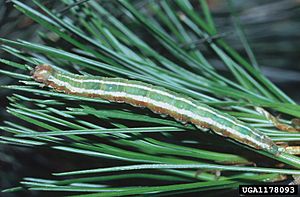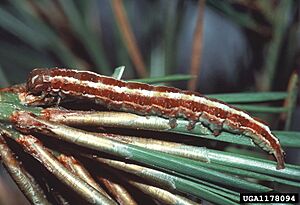Brown-spotted zale facts for kids
Quick facts for kids Brown-spotted zale |
|
|---|---|
 |
|
| Northern variant | |
| Scientific classification | |
| Kingdom: | |
| Phylum: | |
| Class: | |
| Order: | |
| Family: | |
| Genus: |
Zale
|
| Species: |
Z. helata
|
| Binomial name | |
| Zale helata McDunnough, 1943
|
|
| Synonyms | |
|
|
The brown-spotted zale (scientific name: Zale helata) is a type of moth. It belongs to a large family of moths called Noctuidae. A scientist named James Halliday McDunnough first officially described this moth in 1943.
Where Do Brown-Spotted Zale Moths Live?
You can find the brown-spotted zale moth in certain parts of North America. They like to live in open, rocky areas called "barrens" and in pine forests. Their habitat stretches from Manitoba in Canada, across to Maine in the eastern United States. They also live further south, reaching northern Alabama and Texas.
What Do Brown-Spotted Zale Moths Look Like?
These moths are not very big. Their wingspan (the distance from one wingtip to the other) is usually between 35 and 41 millimeters. That's about the length of a few paper clips lined up! The name "brown-spotted zale" gives you a clue about their appearance.
Life Cycle and What They Eat
Adult brown-spotted zale moths are usually seen flying from May to June. They have one generation each year, meaning they complete their life cycle from egg to adult once per year.
The young moths, called larvae (or caterpillars), enjoy eating pine trees. They especially like Pinus virginiana, which is also known as scrub or Virginia pine in the southern parts of their habitat. Sometimes, they might also eat larch trees. These caterpillars prefer to munch on young pine needles that are still soft and haven't fully hardened yet.


